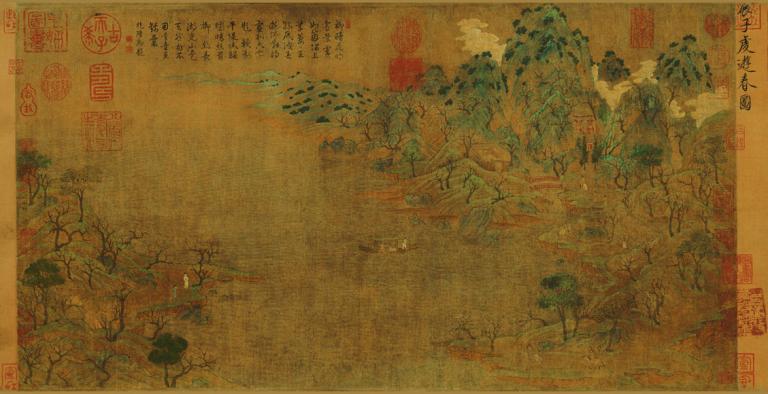Landscape Painting
4 min readPaintings of mountain and water or landscape painting is a traditional Chinese painting with natural sceneries as its depicting object. It gained great developmen in Sui and Tang dynasties. According to the painting history,”the development of landscape painting started from Wu Daozi, and accomplished by Li Sixun and Li Zhaodao.”Actually before Wu Daozi, Li Sixun and Li Zhaodao,a painter named Zhan Ziqian in Sui dynasty had created mature landscape painting, which was quite different from that of the Six dynasties. His work Strolling About in Spring hadsuccessfully formed the shape and charm of natural landscapes using perspective arrangement. His painting provided the viewers with a good sense of space and poetic beauty of natural sceneries.

In Tang dynasty, Li Sixun and his son Li Zhaodao both inherited the style of Zhan Ziqian. Based on the blue and green landscape painting, they created gold landscape painting, which was with profound meaning, splendor and full of sentiment. Then Wu Daozi used bold and unconstrained vigorous way in landscape painting. After the flourishing period of Tang dynasty, Lu Hongchang was well known for his landscape, trees and stones, among which the Straw House was acclaimed by later painters and was influential in the painting history. Wang Wei, as a poet, also made achievement in painting. He was apt in depicting hermits’ life, especially the use of tincture. He created ink-splashing way of painting, using large amount of ink in painting. He was the very first who started to use water and ink in landscape painting and was very influential among later painters. After Middle Tang, water andink landscape painting gained further development with abundant skills and precise creating attitude. Another painter named Zhang Zao was outstanding in pine painting.
He could use both hands in painting, which revealed his overwhelming paintingskills. Besides, Wang Mo and Xiang Rong were experts in using ink in landscape painting.
Important landscape painters in the Sui and Tang dynasties include the following:
Zhan Ziqian, from Bohai(in Shangdong province today), had experienced Northern Qi and Northern Zhou dynasties. It is known that in the Sui dynasty he was appointed to Grand Master for Closing Court and later of Escort Commander-in-Chief. He was good at Buddhist and Taoist painting, figure painting, paintings of horse, court carriages, palaces and gardens and birds, especially landscape paintings. His work Strolling About in Spring remained to be the earliest landscape painting even till this day. The painting depicts a sunny March day in spring with green trees and colorful flowers when noble men and women were riding or boating, enjoying the spring scenery. It is especially successful in the perspectives arrangement of green mountains and the large, far-reaching lake, which seemed so near each other while actually very far way.
Li Sixun (651-716), with the courtesy name Jian, was relatives to the royal family of Tang dynasty. He had been the Right Military General, so in painting history he was known as Senior General Li. He was well known for his paintings of landscapes, pavilions, Buddhist and Taoist Painting, flowers and plants, birds an animals, especially gold landscape painting which was outstanding throughout the painting history. He learned landscape painting from Zhan Ziqian and his style was splendid and meaningful with vigorous lines and sheer structures. The color was divided evenly and in a classic decorative way. He greatly influenced the blue andgreen landscape painting. He was honored by Dong Qichang (1555-1636) in Ming dynastas the Ancestor of Northern School. One of his works left to today was Sailings in the River, Buildings and Pavilions.

Wang Wei(701-761), with courtesy name Mojie, had his ancestral home in Qi County of Shanxi province. He was a famous poet in the flourishing period of Tang dynasty. As he once served as an officer titled Right Aide to the Imperial Secretary, he was also known as Wang Youcheng from his post. Although he was most famous for his poem, he was fond of painting. He once said, though he was a poet this life, he must be a painter in the previous one. He excelled in water and ink landscape painting. He applied ink-splashing way in painting the landscape of Lantian, the place of his hermitic residence. His paintings were full of poetry and Su Shi(1037-1101),a famous writer in Song dynasty, praised that reading his poem.
One can see a painting, while appreciating his painting is like reading a poem. Hisresidence Wangchuan Villa became a symbolic home for later literati and painters.
And he was honored by his followers as the founder of the Southern School painting and the originator of literati painting.









